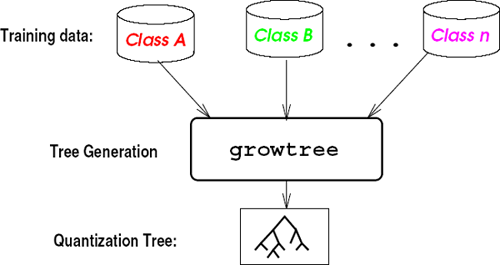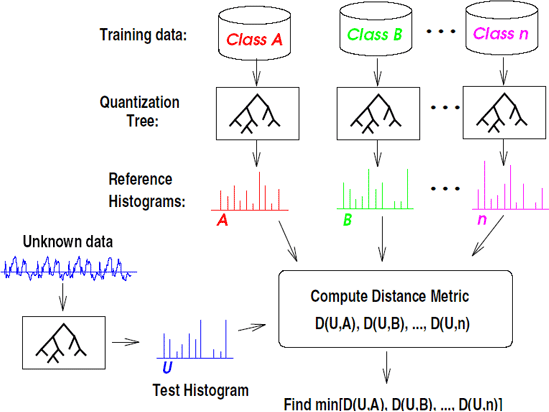Welcome!
The TreeQ package is a
set of C-language applications that implement machine learning
algorithms using a tree-structured classifier. This approach is
particularly effective for high-dimensional continuous data
such as audio and video. Written in vanilla C, TreeQ is highly
portable, depends on no external libraries, and is released
under a BSD
license. TreeQ is being used
by research groups and companies worldwide. Because TreeQ
is a tree-based Vector Quantizer, "TreeQ" is
pronounced "tree-cue," to rhyme with "VQ."
About TreeQ
- The following diagrams show how TreeQ can be used to
build an audio classifier. First, the audio waveform is
processed into a spectral representation, stored in data
files in the "fff" format.
(Note that TreeQ does not do this first step; use
HCopy from
the HTK tools
available from Cambridge University. fff files are
compatible with HTK files.)
top
- The next step is to "quantize" each vector using a
quantization tree computed by TreeQ. This recursively divides
the vector space into bins, each of which corresponds to a
leaf of the tree. The growtreeprogram
in TreeQ constructs a quantization tree given training data
such that different kinds of audio will tend to wind up in
different bins, as shown here:

top
Once a tree has been constructed, it can be used to quantize
input data, using the TreeQ program probtree. Any
input vector will fall into one and only one bin. Given any
input data, the distribution of the vectors in the various
bins characterize that data. For each input file, counting
how many vectors fall into each bin yields a histogram file
that is used in the distance measure.
Once histograms have been computed, they can be used as a
compact representation of the source audio. Similar audio
will have similar histograms, and a distance measure between
the histograms can classify and rank audio by similarity. The
histdist
program computes the distance between histograms, using a
number of possible distance measures. A straightforward use
of histdist is a
search engine for audio. Given a number of audio examples,
they can be ranked by similarity to produce a ranked list
like a conventional text search engine.

Another use of histdist is
shown in the diagram above. Reference histograms are computed
for a number of different classes, say, speech and music
given example training data. An unknown audio sample may be
classified by how similar it is to the reference
histograms. If the input data has the smallest histogram
distance from the music histogram, then the unknown data is
classified as music.
top
TreeQ Applications
This section lists some systems using TreeQ:
top
TreeQ Publications
Publications
describing research use of
TreeQ:
- D. Pye. “Content-Based Methods for the
Management of Digital Musicâ€. In Proc. ICASSP, Vol. IV,
pp.2437-2440, 2000
- Keiichiro Hoashi, Kazunori Matsumoto, and Naomi Inoue,
"Personalization of user profiles for content-based music
retrieval based on relevance feedback," In Proc. ACM
Multimedia 2003, pp. 110-119, Berkeley, CA
top


